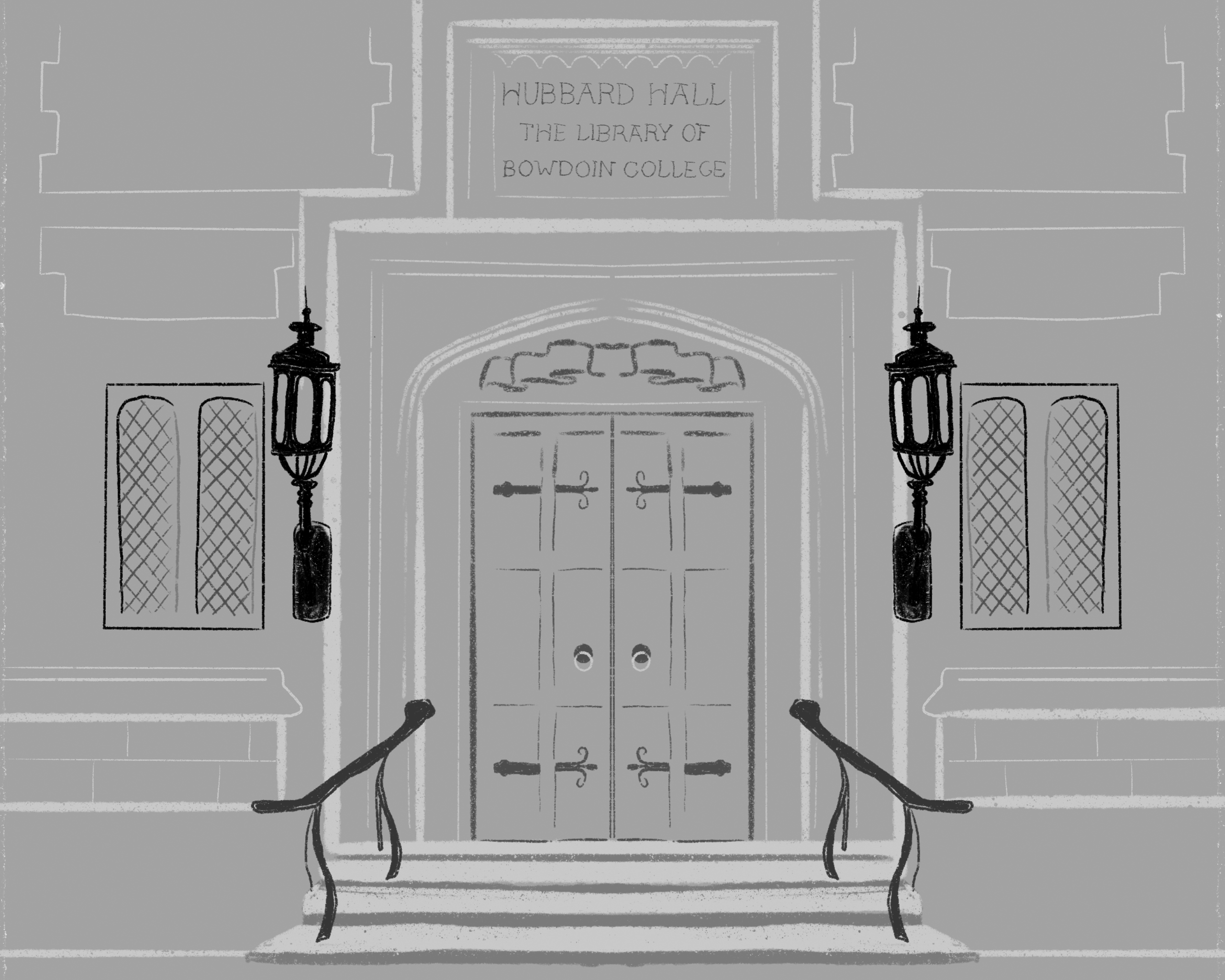Chronicles and namesakes
October 20, 2023
 Eva Ahn
Eva AhnThis week, in my third set of inquiries, I tackled two things near and dear to my Bowdoin experience: the libraries and Frank J. Wood.
One of my friends came to me practically on fire with the first question: What’s the deal with the economics and government libraries in Hubbard Hall? As a frequenter of the economics library on the first floor of Hubbard and both the Shannon and Pickering rooms on the second, I was also intrigued by these seemingly unclaimed collections.
My first inclination was to go right to the source: a librarian.
Bowdoin archivist Anne Sauer believed the libraries were likely leftover collections from when the library system at Bowdoin was run by individual departments.
Before the construction of Hubbard in 1903, each department controlled the circulation of its own collections, meaning students would often peruse various department libraries before finding the one that housed their desired book. Over time, Hubbard eventually housed all the department books.
“The classical education with its timeless certainties in which early Bowdoin took pride had given way to a curriculum that recognized an expanding body of knowledge. The new library was the physical embodiment of an educational philosophy that owed much to the sciences and to the influence of the German universities,” historian Patricia McGraw Anderson writes in her book “Architecture of Bowdoin College.”
If that doesn’t scream liberal arts, I don’t know what does. Hubbard was the main library on campus until 1965 when Hawthorne-Longfellow Library (H-L) was completed, which began the arduous process of moving books and repurposing the massive Hubbard space. This brings us back to the question at hand: What’s the deal with the econ and gov libraries still there today?
To find an answer, I contacted Academic Coordinator in Economics Susan Kohorn. Kohorn reports that around 30 years ago, the circulating books and journals in the economics library were transferred to H-L, and the remaining books are not available for circulation.
“What remains are the paper versions of some journals, retired editions of textbooks and many books collected over the years by faculty members in the department, which later moved to the economics library as faculty members retired,” Kohorn wrote in an email.
There is more uncertainty about the collections in the Shannon and Pickering rooms, and, laughably, I was referred to my Orient colleague Ari Bersch ’25 for information. Sometimes the answers you seek are right under your nose.
Bersch reported that the books in the Shannon room are primarily professors’ books from the early 2000s and government students’ honors projects, which are bound every year. These books are unavailable for circulation.
Some books in the Pickering Room have a dingier history, with a good number found in the eaves of the third floor of Hubbard when they renovated the room a decade ago. Some of the books found had to be taken out by curators in hazmats because of the avian fecal matter they had accrued.
These hidden relics of the century-old library system of splitting up collections by departments show how persistent a history can be.
The endurance of history is the perfect segue into my subsequent investigation: Frank J. Wood. Since my first days at the College, Frank J. Wood has been a recurring visitor in my mind. Maybe it’s because of the resilient bridge renovation picketing campaign led by the Friends of FJWB or the sign for the bridge that triggers a Pavlovian tightening of my grip on the steering wheel as I cross its rusty trusses.
Either way, Frank J. Wood has been a constant character in my Bowdoin experience, begging the question: Who is Frank J. Wood?
With some local newspaper digging, I found an answer I wasn’t particularly expecting. Joseph Frank Wood owned a farm in Topsham and wanted to expand his business to Brunswick, but, unfortunately, the original bridge connecting the two towns was destroyed by a flood in 1929. Thus, Wood began his fight for a new bridge that would last.
Wood fought for over a year to have the new steel bridge placed slightly downstream from its original location by the mill to avoid future flooding. Ultimately, he won the fight, and the bridge still stands in his desired location.
“The Brunswick Record believes that public sentiment justifies the proposal it now makes that the new Brunswick-Topsham bridge be named the ‘Frank J. Wood Bridge.’ ‘Punsters are warned that we have already considered that it is a steel bridge. We believe that the bridge should carry a plate so marked as a tribute to a man who had an idea and carried it through,’” the Sun Journal from Lewiston wrote in its February 26, 1932 edition.
Now, as the FJWB faces its imminent demise in the next few years, I can’t help but wonder who the next bridge will be named after. Had the Friends of FJWB won their years-long court battle, we might be driving across the John Graham bridge, named after the organization’s president who fought to save the historic relic.
While I noticeably feel my heart rate rise every time I cross the oxidized structure, I can now appreciate it as a symbol of a different time of local politics when the townspeople could win the day. Next time I cross the FJWB, I will let my mind wander to Wood and his local government battle until I safely reach the other side.
Ari Bersch is a member of the Bowdoin Orient.

Comments
Before submitting a comment, please review our comment policy. Some key points from the policy: